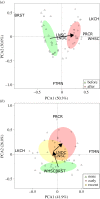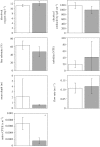Native freshwater species get out of the way: Prussian carp (Carassius gibelio) impacts both fish and benthic invertebrate communities in North America
- PMID: 29134062
- PMCID: PMC5666245
- DOI: 10.1098/rsos.170400
Native freshwater species get out of the way: Prussian carp (Carassius gibelio) impacts both fish and benthic invertebrate communities in North America
Abstract
Prussian carp (Carassius gibelio) are one of the most noxious non-native species in Eurasia. Recently, Prussian carp, a non-native freshwater fish species, were genetically confirmed in Alberta, Canada and have been rapidly expanding their range in North America since establishment. Given their rapid range expansion, there is an increasing need to determine how Prussian carp may impact native species. We assessed the severity of the Prussian carp invasion by (i) determining their impact on fish communities, (ii) assessing their impact on benthic invertebrate communities, (iii) evaluating if Prussian carp alter abiotic conditions, and (iv) identifying where we find higher abundances of Prussian carp. When Prussian carp were established, we found significant changes to the fish community. Correspondingly, the degree of impact to benthic invertebrate communities was related to the stage of invasion (none, early or recent), where changes in fish communities were significantly concordant with changes in benthic invertebrate communities. Finally, we found that higher abundances of Prussian carp were significantly associated with lower abundances of a majority of native fish species. Altogether, using three lines of evidence, we determine that Prussian carp can have wide-ranging impacts on freshwater ecosystems in North America, pressing the need for management intervention.
Keywords: before–after comparison; benthic invertebrates; concordance; freshwater fishes; non-native species; time since invasion.
Conflict of interest statement
All authors declare that there are no competing interests.
Figures





References
-
- Sala OE, et al. 2000. Biodiversity: global biodiversity scenarios for the year 2100. Science 287, 1770–1774. (doi:10.1126/science.287.5459.1770) - DOI - PubMed
-
- Dudgeon D, et al. 2006. Freshwater biodiversity: importance, threats, status and conservation challenges. Biol. Rev. 81, 163–182. (doi:10.1017/S1464793105006950) - DOI - PubMed
-
- Early R, et al. 2016. Global threats from invasive alien species in the twenty-first century and national response capacities. Nat. Commun. 7, 9 (doi:10.1038/ncomms12485) - DOI - PMC - PubMed
-
- Olden JD, Poff NL, Douglas MR, Douglas ME, Fausch KD. 2004. Ecological and evolutionary consequences of biotic homogenization. Trends Ecol. Evol. 19, 18–24. (doi:10.1016/j.tree.2003.09.010) - DOI - PubMed
-
- Jeschke JM, et al. 2014. Defining the impact of non-native species. Conserv. Biol. 28, 1188–1194. (doi:10.1111/cobi.12299) - DOI - PMC - PubMed
Associated data
LinkOut - more resources
Full Text Sources
Other Literature Sources
Research Materials
